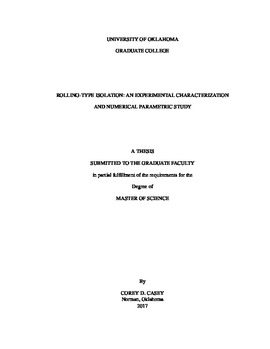| dc.contributor.advisor | Harvey, P. Scott | |
| dc.contributor.author | Casey, Corey | |
| dc.date.accessioned | 2017-12-18T18:42:23Z | |
| dc.date.available | 2017-12-18T18:42:23Z | |
| dc.date.issued | 2017-12-15 | |
| dc.identifier.uri | https://hdl.handle.net/11244/53085 | |
| dc.description.abstract | Building contents and nonstructural components are known to be vulnerable during seismic events. Of particular concern is computer and network equipment that is critical in the post-earthquake recovery process. A solution for mitigating the seismic hazard to such systems is rolling-type isolation systems (RISs), but the characterization of RISs with realistic loading conditions and system setups is not well documented. An experimental parametric case study was performed varying the mass eccentricity, the number of cabinets, and the damping to simulate in-service conditions. A series of free response tests was performed using an abrupt shake table displacement (pulse) along with forced response tests utilizing the VERTEQ-II Zone-4 waveform. An array or string potentiometers and accelerometers measured the longitudinal, transverse, and rotational responses of the systems. Supplementally damped systems were found to have increased rotations when a mass eccentricity was present. The increase in system size and mass reduced the overall rotations due to an increased restoring moment arm and higher mass moment of inertia. Increased damping decreased the displacement demand on the isolator but increased the overall accelerations slightly. However, the systems without the supplemental damping had such large displacements that impacts were experienced causing excessively high accelerations. Durability was an issue for lightly damped systems due to increased contact stress between the ball and concave rolling surface.
A physics-based mathematical model was developed for the prediction of the response of multi-unit RIS arrays with mass eccentricity. The model was first calibrated to the experimental free response tests and then validated with the forced response tests. The validated model was then used to perform a numerical parametric case study. Configurations with one, two, four and eight cabinets were modeled, and the eccentricity was varied. The VERTEQ-II waveform was applied in both the front-to-back and side-to-side directions under varying ground motion scaling. Impacts are predicted at lower ground motion scaling with larger mass eccentricity due to the initiation of rotations. The ground motion scaling for which impacts occur is increased due to the systems higher resistance to rotations from increased number of isolated cabinets. Finally, capacity design curves for the impact point were determined, which can be used to establish the required configuration (number of cabinets and eccentricity) for a given ground motion intensity. | en_US |
| dc.language | en_US | en_US |
| dc.subject | rolling isolation, component isolation, equipment, seismic mitigation | en_US |
| dc.title | ROLLING-TYPE ISOLATION: AN EXPERIMENTAL CHARACTERIZATION AND NUMERICAL PARAMETRIC STUDY | en_US |
| dc.contributor.committeeMember | Floyd, Royce | |
| dc.contributor.committeeMember | Pei, Jin-Song | |
| dc.date.manuscript | 2017-12-15 | |
| dc.thesis.degree | Master of Science | en_US |
| ou.group | College of Engineering::School of Civil Engineering and Environmental Science | en_US |
